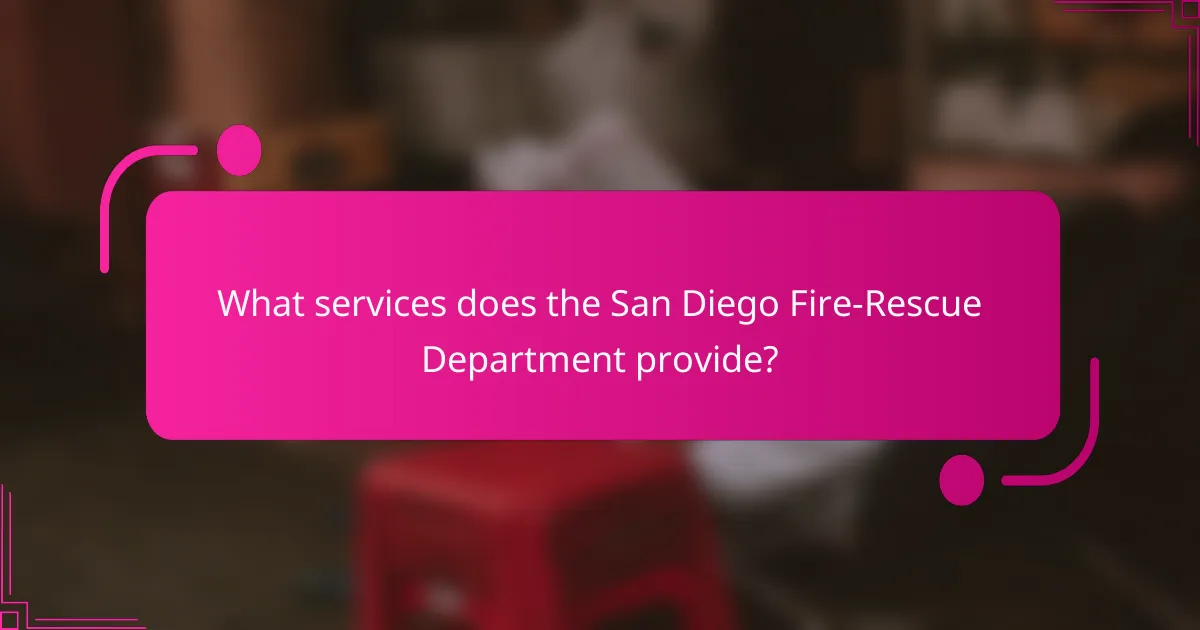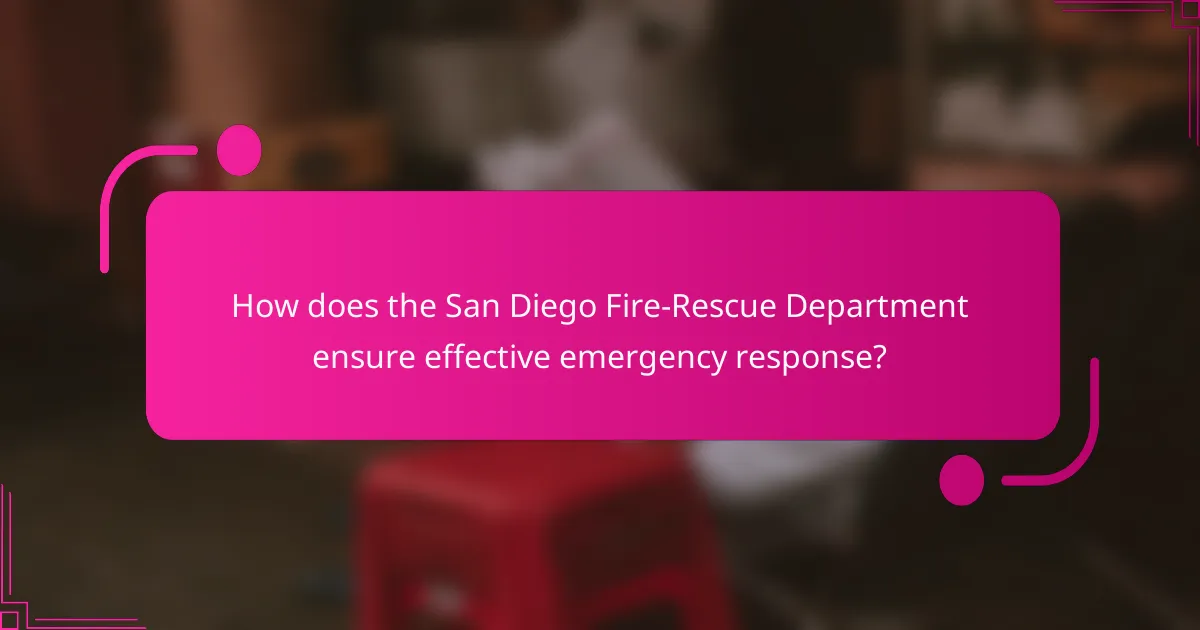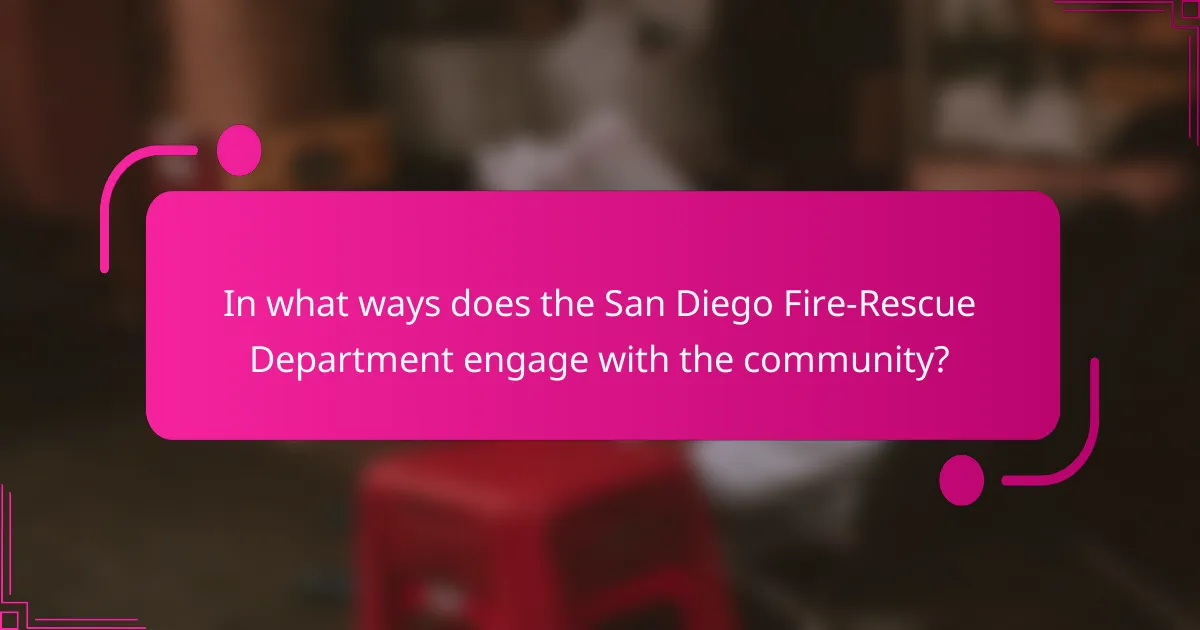
What services does the San Diego Fire-Rescue Department provide?
The San Diego Fire-Rescue Department provides emergency response, fire prevention, and community education services. Emergency response includes fire suppression, rescue operations, and medical aid. The department responds to thousands of emergency calls annually, ensuring public safety. Fire prevention services involve inspections, code enforcement, and public education on fire safety. Community education includes programs that teach residents about disaster preparedness and fire safety. The department also offers resources for emergency planning and response coordination. Overall, these services aim to protect lives and property in San Diego.
How does the San Diego Fire-Rescue Department respond to emergencies?
The San Diego Fire-Rescue Department responds to emergencies through a coordinated approach. This includes dispatching fire engines, ambulances, and other specialized units. Each unit is staffed with trained personnel ready to handle various emergency situations. The department utilizes a comprehensive communication system for quick response times. They also conduct regular training exercises to maintain readiness. Emergency response plans are regularly reviewed and updated. The department collaborates with other agencies for large-scale incidents. This ensures efficient resource allocation and effective emergency management.
What types of emergencies does the department typically handle?
The San Diego Fire-Rescue Department typically handles fires, medical emergencies, and hazardous materials incidents. Fires include structural fires, wildfires, and vehicle fires. Medical emergencies encompass a range of situations, such as cardiac arrests and trauma incidents. Hazardous materials incidents involve spills and leaks of toxic substances. Additionally, the department responds to rescue operations, including water rescues and technical rescues. Each type of emergency requires specialized training and equipment to ensure effective response and safety.
What is the response time for emergency calls?
The response time for emergency calls in San Diego is typically around 5 to 7 minutes. This timeframe is measured from when the call is received to when emergency services arrive on the scene. The San Diego Fire-Rescue Department aims to meet this standard consistently. Factors such as traffic, location, and the nature of the emergency can influence actual response times. Historical data shows that the department has maintained an average response time within this range for several years.
What role does community education play in the department’s services?
Community education plays a vital role in the San Diego Fire-Rescue Department’s services. It enhances public awareness about fire safety and prevention. Through various programs, the department educates residents on emergency preparedness. This education reduces the risk of fire-related incidents in the community. For example, the department conducts workshops and demonstrations on using fire extinguishers. Additionally, community education fosters partnerships between the department and local organizations. These collaborations amplify outreach efforts and resources. Overall, community education is essential for promoting safety and resilience in the community.
What programs does the San Diego Fire-Rescue Department offer for community education?
The San Diego Fire-Rescue Department offers several programs for community education. These include fire safety education, CPR training, and emergency preparedness workshops. Fire safety education programs teach residents about fire prevention and safety practices. CPR training equips individuals with life-saving skills for cardiac emergencies. Emergency preparedness workshops provide guidance on how to prepare for disasters. Each program aims to enhance community safety and awareness. The department regularly updates these programs to meet community needs.
How can community members participate in these educational programs?
Community members can participate in educational programs offered by the San Diego Fire-Rescue Department by enrolling in available classes and workshops. These programs often include fire safety training, CPR certification, and disaster preparedness sessions. Registration for these programs can typically be done through the department’s official website or local community centers. Attendance at community events hosted by the department also provides opportunities for participation. Engaging in volunteer programs with the department can further enhance community involvement. These educational initiatives aim to equip residents with essential skills and knowledge for safety and emergency response.
What is the significance of resource allocation within the department?
Resource allocation within the San Diego Fire-Rescue Department is critical for operational efficiency. It ensures that personnel, equipment, and funding are distributed effectively to meet emergency response needs. Proper allocation enhances response times during incidents, improving public safety. Additionally, it allows for adequate training and community education initiatives. Studies show that departments with optimized resource allocation experience better outcomes in emergency situations. Efficient resource management leads to reduced operational costs and maximizes the department’s effectiveness. Therefore, resource allocation directly influences the department’s ability to serve the community effectively.
How does the San Diego Fire-Rescue Department allocate its resources?
The San Diego Fire-Rescue Department allocates its resources based on community risk assessments and operational needs. This allocation involves analyzing data on fire incidents, emergency medical calls, and community demographics. The department prioritizes resource distribution to areas with higher call volumes and greater risks. Staffing levels are adjusted according to the time of day and expected demand. Additionally, resources are allocated for community education and prevention programs. The department uses a strategic plan that incorporates input from local stakeholders. This approach ensures efficient use of personnel and equipment. Overall, the resource allocation process aims to enhance public safety and response times.
What factors influence resource allocation decisions?
Resource allocation decisions are influenced by various factors including budget constraints, operational needs, and community risk assessments. Budget constraints dictate the available financial resources for allocation. Operational needs focus on the immediate requirements of emergency services. Community risk assessments evaluate the potential hazards and demands within the community. These factors work together to ensure efficient and effective resource distribution. For example, a higher incidence of fires in a specific area may lead to increased resource allocation there. Additionally, historical data on emergency incidents can inform future allocation strategies.

How does the San Diego Fire-Rescue Department ensure effective emergency response?
The San Diego Fire-Rescue Department ensures effective emergency response through comprehensive training and advanced technology. They conduct regular drills for firefighters to maintain readiness. The department utilizes a sophisticated dispatch system for quick response times. They also collaborate with other emergency services for coordinated efforts. Community education programs enhance public awareness of safety protocols. The department employs data analysis to identify high-risk areas for resource allocation. Their fleet includes modern fire engines equipped with the latest firefighting tools. Continuous evaluation of response strategies helps improve overall effectiveness.
What training do firefighters receive for emergency response?
Firefighters receive extensive training for emergency response. This training includes fire suppression techniques, search and rescue operations, and emergency medical services. They also learn hazardous materials handling and incident command systems. Training often involves live drills and simulations to prepare for real-life scenarios. Firefighters must complete certification programs, such as those from the National Fire Protection Association (NFPA). Additionally, ongoing training is required to stay updated on new protocols and technologies. This comprehensive approach ensures firefighters are equipped to handle various emergencies effectively.
What specialized skills are emphasized in firefighter training?
Firefighter training emphasizes specialized skills such as fire suppression, emergency medical response, and hazardous materials handling. Fire suppression skills include techniques for extinguishing fires and managing dangerous situations. Emergency medical response training prepares firefighters to provide life-saving care. Hazardous materials handling teaches them how to safely manage chemical spills and other dangerous substances. Additionally, physical fitness and teamwork are crucial components of training. These skills ensure firefighters can effectively respond to emergencies and protect public safety.
How often is training updated to reflect new practices?
Training is updated biannually to reflect new practices. This schedule ensures that personnel stay current with the latest techniques and protocols. The San Diego Fire-Rescue Department reviews training materials every six months. Updates incorporate feedback from recent incidents and advancements in firefighting techniques. Additionally, new regulations and safety standards are integrated during these updates. This systematic approach enhances the effectiveness of emergency response. Regular training updates are essential for maintaining high operational standards.
What technologies does the department use to enhance emergency response?
The San Diego Fire-Rescue Department uses advanced technologies to enhance emergency response. These technologies include computer-aided dispatch systems that improve call handling and resource allocation. Geographic Information Systems (GIS) are utilized for mapping and analyzing emergency incidents. Mobile data terminals in fire trucks provide real-time information to responders. Drones are deployed for aerial surveillance and assessment during large incidents. Additionally, the department employs software for predictive analytics to anticipate high-risk areas. These technologies collectively improve response times and operational efficiency.
How do communication systems improve response efficiency?
Communication systems enhance response efficiency by facilitating rapid information exchange. They enable real-time coordination among emergency responders. This leads to quicker decision-making during critical situations. For instance, the San Diego Fire-Rescue Department utilizes advanced communication technology. This includes radio systems and mobile data terminals. Such tools allow for immediate updates on incidents and resource availability. Studies show that effective communication reduces response times by up to 25%. Improved communication also minimizes misunderstandings among team members. Overall, these systems streamline operations and enhance overall effectiveness in emergency response.
What role does data analysis play in emergency response planning?
Data analysis plays a crucial role in emergency response planning. It enables agencies to assess risks and identify vulnerable areas. By analyzing historical data, responders can predict potential emergencies and allocate resources effectively. Data analysis also helps in optimizing response times and improving coordination among agencies. For example, the San Diego Fire-Rescue Department utilizes data to enhance fire response strategies. This approach is supported by studies showing that data-driven decision-making improves emergency outcomes.

In what ways does the San Diego Fire-Rescue Department engage with the community?
The San Diego Fire-Rescue Department engages with the community through various programs and initiatives. They conduct educational outreach programs in schools to promote fire safety. The department hosts community events, such as open houses and safety fairs, to interact with residents. They offer CPR and first aid training sessions for community members. The department also participates in neighborhood meetings to address local concerns. Additionally, they collaborate with local organizations for public safety campaigns. Their engagement efforts aim to build trust and enhance public safety awareness. These activities reflect their commitment to community involvement and education.
What initiatives promote community safety and awareness?
Initiatives that promote community safety and awareness include educational programs, community engagement events, and safety workshops. The San Diego Fire-Rescue Department conducts regular fire safety education sessions in schools and community centers. These sessions teach residents about fire prevention and emergency preparedness. Community engagement events, such as open houses, allow residents to interact with firefighters and learn about safety resources. Additionally, safety workshops cover topics like CPR training and disaster response. These initiatives aim to empower residents with knowledge and skills. Statistics show that communities with active safety programs experience fewer emergencies. Engaging the public fosters a culture of safety and preparedness.
How does the department collaborate with local organizations for safety programs?
The San Diego Fire-Rescue Department collaborates with local organizations through joint initiatives and resource sharing. This collaboration includes training sessions, safety workshops, and community outreach programs. The department partners with non-profits, schools, and local businesses to enhance public safety awareness. They also participate in community events to promote safety education. For instance, the department conducts fire safety demonstrations in collaboration with local schools. These partnerships help to disseminate critical safety information effectively. The department’s engagement with local organizations strengthens community resilience against emergencies.
What outreach events are organized to educate the public about fire safety?
The San Diego Fire-Rescue Department organizes several outreach events to educate the public about fire safety. These events include fire safety presentations in schools and community centers. They also host open houses at fire stations to engage with the community. Fire extinguisher training sessions are offered to teach proper usage. Additionally, the department conducts community drills to practice emergency response. Public awareness campaigns are launched during Fire Prevention Week. These initiatives aim to reduce fire risks and promote safety awareness. Statistics show that community education significantly lowers fire incidents.
How can residents access resources and support from the department?
Residents can access resources and support from the San Diego Fire-Rescue Department through various channels. They can visit the department’s official website for information on services and programs. The website offers resources on fire safety, emergency preparedness, and community education. Residents can also contact the department directly via phone or email for specific inquiries. Additionally, the department holds community events and workshops to engage with residents. These events provide hands-on education and resources related to fire safety and emergency response. By utilizing these channels, residents can effectively access the support they need.
What online resources are available for community members?
The San Diego Fire-Rescue Department offers several online resources for community members. These include access to emergency preparedness guides. Community members can find information on fire safety and prevention. The department also provides online training materials for CPR and first aid. Additionally, there are resources for reporting hazards and requesting inspections. The website features a calendar of community events and educational workshops. Members can also access social media updates for real-time information. All of these resources aim to enhance community safety and awareness.
How can residents report concerns or request assistance?
Residents can report concerns or request assistance by contacting the San Diego Fire-Rescue Department directly. They can call the department’s non-emergency number at 619-533-4300. Residents may also visit the department’s official website to submit inquiries or concerns online. Additionally, for urgent matters, residents can dial 911 for immediate assistance. The department encourages community engagement and feedback to enhance service delivery. This process ensures that residents receive timely help and that their concerns are addressed effectively.
What best practices can residents follow to enhance their safety in emergencies?
Residents can enhance their safety in emergencies by developing a comprehensive emergency plan. This plan should include identifying escape routes and meeting points. Regularly practicing drills can help ensure everyone knows what to do. Residents should also keep emergency supplies readily available. Supplies should include water, food, first aid kits, and flashlights. Staying informed about local emergency services is crucial. Residents should sign up for alerts from the San Diego Fire-Rescue Department. This ensures timely updates on emergencies. Additionally, maintaining clear communication with family members is essential. Regular discussions about safety protocols can improve preparedness.
The San Diego Fire-Rescue Department is the primary entity responsible for emergency response, fire prevention, and community education in San Diego. This article outlines the department’s services, including their approach to emergency response, typical emergencies handled, and the importance of community education in enhancing public safety. It also highlights resource allocation strategies, training for firefighters, and the use of advanced technologies to improve response efficiency. Additionally, the article discusses community engagement initiatives and available resources for residents, emphasizing the department’s commitment to safety and preparedness.